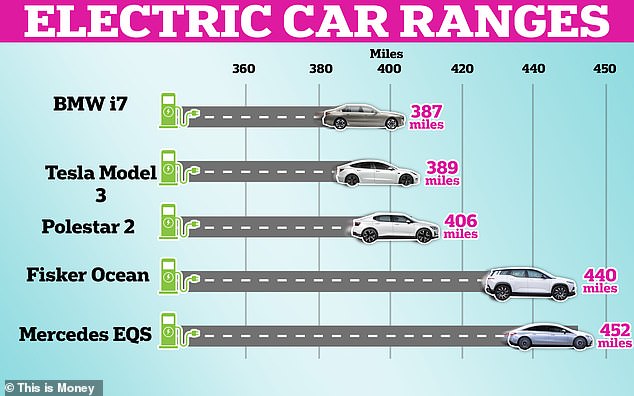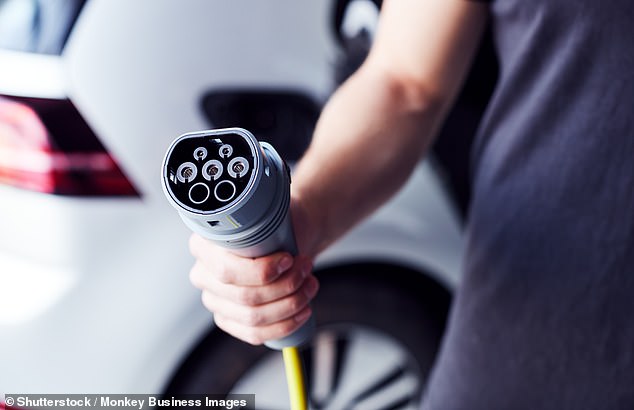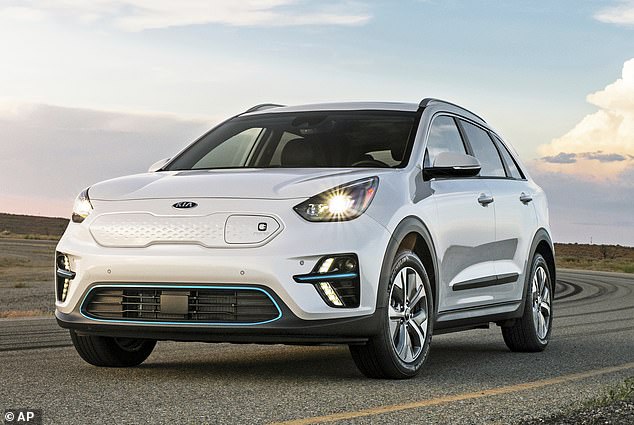Table of Contents
- How is EV fuel efficiency calculated and what is considered “good” EV efficiency? Kilometers per kWh explained
There’s one number every cost-conscious driver wants to know about their car: miles per gallon (MPG).
This figure, which measures a vehicle’s fuel efficiency, lets drivers know how many miles their car can travel per gallon of fuel (whether gasoline or diesel).
Most people will look for models with the highest MPG figures possible because they will keep running costs down and reduce the number of times they need to refuel.
Carwow found that almost four in five (78 percent) people have no idea how to calculate miles per kWh for an electric vehicle, which is becoming a crucial figure to understand as the shift to electric vehicles increases.
But as the country’s car fleet gradually transitions to electric vehicles (there are now more than a million on UK roads), MPG is becoming less and less relevant as a new figure takes over: miles per kWh.
So what is miles/kWh and how do we calculate it? Here’s our guide to calculating the fuel economy of an electric vehicle.
Is it important to know miles/kWh?
Despite 31 per cent of British drivers considering an electric vehicle as their next car, two-thirds admit to not understanding the fuel efficiency of an electric car, research from Carwow shows.
And nearly four in five have no idea how to calculate miles per kWh for an electric vehicle.
How are miles/kWh calculated?
Any electric vehicle you buy will state the size of the car’s battery in kWh in the specification information and will also state the range figure.
The amount of energy stored in the electric vehicle’s cells is measured in kilowatt hours.
KWh:
Like engine size, battery size varies from one EV to the next. A Vauxhall Corsa Electric, for example, has a 48kWh battery, while a larger SUV such as a BMW iX may have a battery of almost double that – 105kWh.
The kWh figure is a “net” capacity figure because manufacturers keep some battery power in reserve to protect the cells, so make sure this is the figure you use for the calculation rather than the “raw” number.
Range:
The range figure in the specifications will usually have the letters WLTP (Worldwide Harmonised Light Vehicle Test Procedure), which represents the real-world range test that all new electric vehicles must undergo.
There is usually more than one listed, so use the “combined” range figure.
Calculation: Divide the combined range figure by the usable (net) battery size to get your EV’s miles/kWh.

There are many cars these days that have very long ranges, but to calculate the miles per kWh or fuel efficiency of your electric vehicle, you need to divide the range figure by the size of the car’s battery.
What kilometers/kWh are “good” for an electric vehicle?
Carwow’s Ian Reid says: ‘Electric vehicles are becoming more efficient as battery technology improves, meaning miles/kWh figures are increasing all the time.
‘Lighter electric vehicles can travel more miles per kWh because their motors don’t have to work as hard.
For miles/kWh: Divide the combined range figure by the usable (net) battery size to get your EV’s miles/kWh
‘However, larger electric vehicles tend to have more batteries, so they offer greater ranges.’
Generally, most new electric cars will have a figure of over 4 miles/kWh, so this should be your benchmark, but expect older, heavier large EV SUVs, such as a Mercedes EQC, to only manage 2.89 miles/kWh.
Currently, the most efficient electric vehicle in Carwow’s directory is the Tesla Model 3, which has a figure of 5.08 miles/kWh.
Compared to a smaller, lighter Fiat 500e, with a range of 4.95 miles/kWh, the Model 3 is particularly good.

To maximize the miles/kWh of an electric vehicle, modify the way you drive: avoid sudden braking or acceleration and use the vehicle’s regenerative braking mode.
How can the kilometers/kWh of an electric vehicle be improved?
Increasing the mileage/kWh of an electric vehicle is similar to increasing the MPG of a gasoline or diesel car: it all depends on how efficiently you drive.
Reid suggests modifying your driving style to maximise your mileage: ‘Hard acceleration and braking affect battery range, so try to be gentler and anticipate the road ahead.
‘Also, choose the regenerative braking program so that the energy you use is not wasted when slowing down.’
Regenerative braking captures energy that would normally be lost during braking and uses it to recharge the vehicle’s battery.
Another tip is to choose a more economical route: ‘Navigation apps like Google Maps offer an ‘Eco’ option that may take a few minutes longer, but will allow for shorter routes and driving at lower speeds.
“The extra time could easily be offset by not having to stop for fuel,” Reid says.



